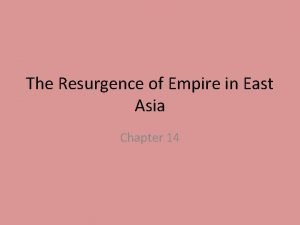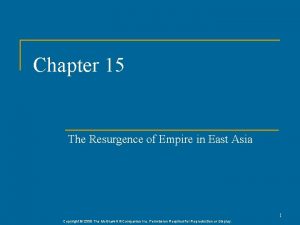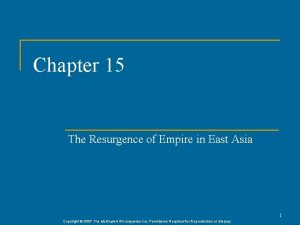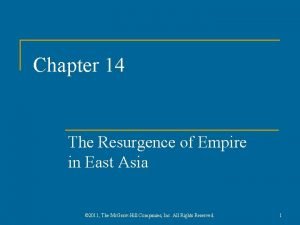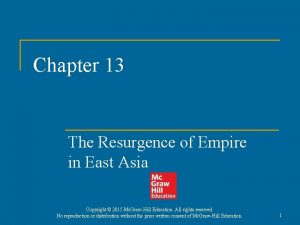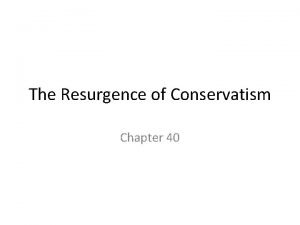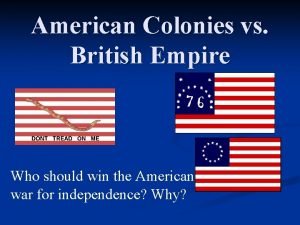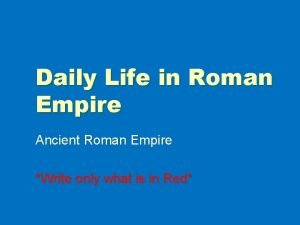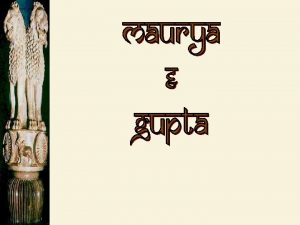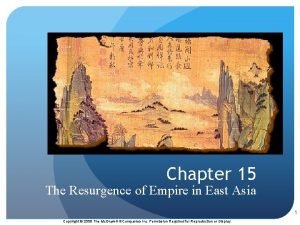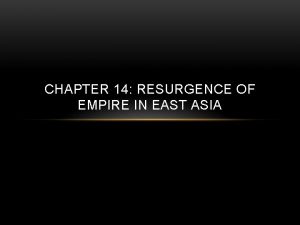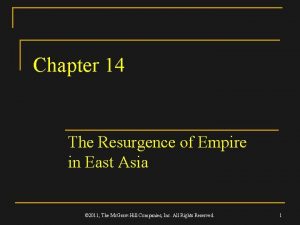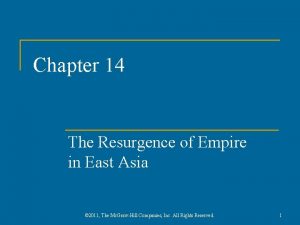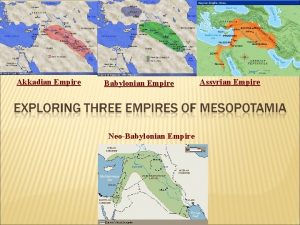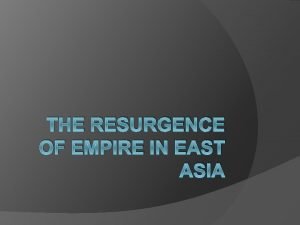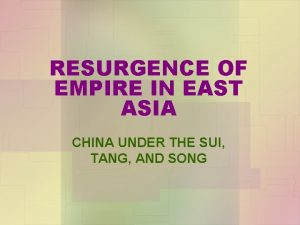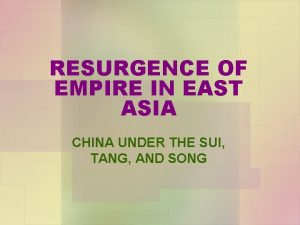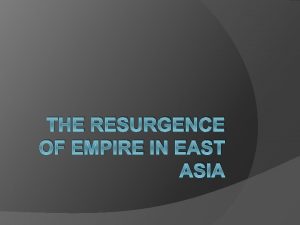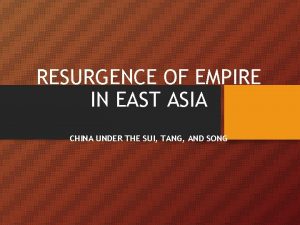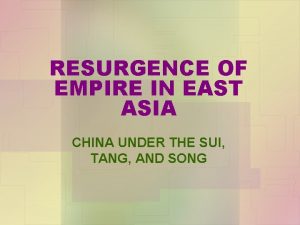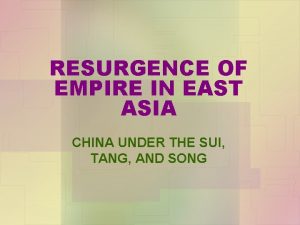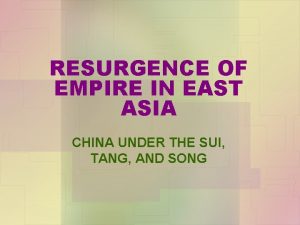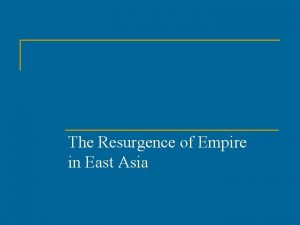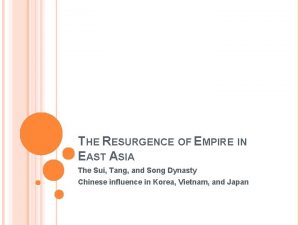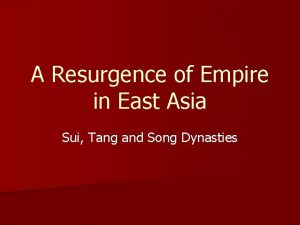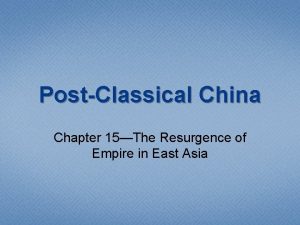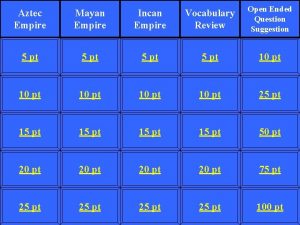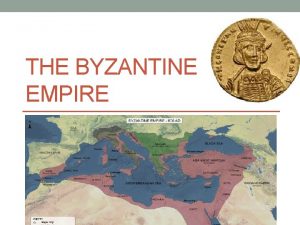Chapter 13 The Resurgence of Empire in East


































- Slides: 34

Chapter 13 The Resurgence of Empire in East Asia Copyright © 2015 Mc. Graw-Hill Education. All rights reserved. No reproduction or distribution without the prior written consent of Mc. Graw-Hill Education. 1

The Sui Dynasty (589– 618 C. E. ) n n n Collapse of Han dynasty, succeeded by regional kingdoms Yang Jian consolidated control of all of China, initiated Sui dynasty Massive building projects q q Military labor Conscripted labor Copyright © 2015 Mc. Graw-Hill Education. All rights reserved. No reproduction or distribution without the prior written consent of Mc. Graw-Hill Education. 2

The Grand Canal n Intended to promote trade between north and south China q n n Most Chinese rivers flow west-east Emperor Sui Yangdi (r. 604– 618 C. E. ) Linked network of earlier canals q q 2, 000 kilometers (1, 240 miles) Roads on either side Copyright © 2015 Mc. Graw-Hill Education. All rights reserved. No reproduction or distribution without the prior written consent of Mc. Graw-Hill Education. 3

The Tang Dynasty (618– 907 C. E. ) n n Wide discontent over conscripted labor under Sui dynasty Rebellion prompted by military failures in Korea Emperor Sui Yangdi assassinated in 618 C. E. Tang dynasty initiated Copyright © 2015 Mc. Graw-Hill Education. All rights reserved. No reproduction or distribution without the prior written consent of Mc. Graw-Hill Education. 4

Tang Taizong n n n Second emperor of Tang dynasty (r. 627– 649 C. E. ) Murdered two brothers, thrust father aside to take throne Strong ruler q q Built capital at Chang’an Law and order Taxes, low prices More effective implementation of earlier Sui policies Copyright © 2015 Mc. Graw-Hill Education. All rights reserved. No reproduction or distribution without the prior written consent of Mc. Graw-Hill Education. 5

Achievements of Tang Dynasty n Transportation and communications q n Extensive postal, courier services Equal-field system q q 20% of land, hereditary ownership 80% redistributed according to formula n q Family size, land fertility Worked well until eighth century n Corruption, loss of land to Buddhist monasteries Copyright © 2015 Mc. Graw-Hill Education. All rights reserved. No reproduction or distribution without the prior written consent of Mc. Graw-Hill Education. 6

Bureaucracy of Merit n Imperial civil service examinations q n Confucian educational curriculum Most candidates advanced through merit q q q Educational opportunity widely available Built loyalty to the dynasty System remained strong until early twentieth century Copyright © 2015 Mc. Graw-Hill Education. All rights reserved. No reproduction or distribution without the prior written consent of Mc. Graw-Hill Education. 7

Tang Military Expansion and Foreign Relations n n n Manchuria, Korea, Vietnam, Tibet One of the largest expansions of China in its history Established tributary relationships q n Gifts China as “Middle Kingdom” q Kowtow ritual Copyright © 2015 Mc. Graw-Hill Education. All rights reserved. No reproduction or distribution without the prior written consent of Mc. Graw-Hill Education. 8

The Sui and Tang Dynasties, 589– 907 C. E. Copyright © 2015 Mc. Graw-Hill Education. All rights reserved. No reproduction or distribution without the prior written consent of Mc. Graw-Hill Education. 9

Tang Decline n n Governmental neglect: emperor obsessed with music, favorite concubine Rebellion under An Lushan, former military commander, 755 C. E. q n n Chang’an captured, but rebellion crushed by 763 C. E. Nomadic Uighur mercenaries, invited to suppress rebellion, sacked Chang’an and Luoyang Tang decline continued through series of ninthcentury rebellions; last emperor abdicated 907 C. E. Copyright © 2015 Mc. Graw-Hill Education. All rights reserved. No reproduction or distribution without the prior written consent of Mc. Graw-Hill Education. 10

The Song Dynasty (960– 1279 C. E. ) n n n Emphasis on administration, industry, education, the arts Military not emphasized Under direction of first emperor, Song Taizu (r. 960– 976 C. E. ) q q q Former military leader Made emperor by troops Instituted policy of imperial favor for civil servants, expanded meritocracy Copyright © 2015 Mc. Graw-Hill Education. All rights reserved. No reproduction or distribution without the prior written consent of Mc. Graw-Hill Education. 11

The Song Dynasty, 960– 1279 C. E. Copyright © 2015 Mc. Graw-Hill Education. All rights reserved. No reproduction or distribution without the prior written consent of Mc. Graw-Hill Education. 12

Song Weaknesses n Size of bureaucracy heavy drain on economy q q n Two peasant rebellions in twelfth century Internal inertia prevented reform of bureaucracy Civil service leadership of military q q q Lacked military training Unable to contain nomadic attacks Nomadic Jurchen conquerors forced Song dynasty to Hangzhou, southern China (Southern Song dynasty) Copyright © 2015 Mc. Graw-Hill Education. All rights reserved. No reproduction or distribution without the prior written consent of Mc. Graw-Hill Education. 13

The Economic Development of Tang and Song China n n Developed Vietnamese fast-ripening rice, two crops per year New agricultural techniques: q q q Use of iron plows, draft animals Soil fertilization, improved irrigation, including use of waterwheels Cultivation in difficult terrain, including terraced mountainsides Copyright © 2015 Mc. Graw-Hill Education. All rights reserved. No reproduction or distribution without the prior written consent of Mc. Graw-Hill Education. 14

Population Growth n n Result of increased agricultural production Effective food distribution system q Transportation networks built under Tang and Song dynasties Copyright © 2015 Mc. Graw-Hill Education. All rights reserved. No reproduction or distribution without the prior written consent of Mc. Graw-Hill Education. 15

Urbanization n n Chang’an was world’s most populous city: two million residents Southern Song capital at Hangzhou: over one million Copyright © 2015 Mc. Graw-Hill Education. All rights reserved. No reproduction or distribution without the prior written consent of Mc. Graw-Hill Education. 16

Patriarchal Social Structures n Increased emphasis on ancestor worship q q n Foot binding gained popularity q n Elaborate grave rituals Extended family gatherings in honor of deceased ancestors Increased control by male family members Wu Zhao (626– 706 C. E. ), the lady emperor q Strengthened civil service system Copyright © 2015 Mc. Graw-Hill Education. All rights reserved. No reproduction or distribution without the prior written consent of Mc. Graw-Hill Education. 17

Technology and Industry n n Porcelain (chinaware) Increase of iron production due to use of coke, not coal, in furnaces q n n Gunpowder invented Earlier printing techniques refined q q n Agricultural tools, weaponry Moveable type by mid-eleventh century Complex Chinese ideographs make wood block technique easier Naval technology Copyright © 2015 Mc. Graw-Hill Education. All rights reserved. No reproduction or distribution without the prior written consent of Mc. Graw-Hill Education. 18

The Emergence of a Market Economy n Letters of credit developed to deal with copper coin shortages q n Development of independently produced paper money q n Promissory notes, checks also used Not as stable; riots when not honored Government claimed monopoly on money production in eleventh century Copyright © 2015 Mc. Graw-Hill Education. All rights reserved. No reproduction or distribution without the prior written consent of Mc. Graw-Hill Education. 19

China and the Hemispheric Economy n n Increasingly cosmopolitan nature of Chinese cities Chinese silk opened up trade routes, but this increased local demands for imported luxury goods Copyright © 2015 Mc. Graw-Hill Education. All rights reserved. No reproduction or distribution without the prior written consent of Mc. Graw-Hill Education. 20

Cultural Change in Tang and Song China n n Declining confidence in Confucianism after collapse of Han dynasty Increasing popularity of Buddhism Christianity, Manichaeism, Zoroastrianism, Islam also appear Clientele primarily of foreign merchant class Copyright © 2015 Mc. Graw-Hill Education. All rights reserved. No reproduction or distribution without the prior written consent of Mc. Graw-Hill Education. 21

Buddhism in China n Sizable Mahayana Buddhist community in Dunhuang, western China, 600– 1000 C. E. q n Buddhist temples, libraries Buddhism attracted interest for moral but also practical reasons q q Economic success as converts donated land holdings Increased popularity through donations of agricultural produce to poor Copyright © 2015 Mc. Graw-Hill Education. All rights reserved. No reproduction or distribution without the prior written consent of Mc. Graw-Hill Education. 22

Conflicts with Chinese Traditions n Buddhism: q q q Text-based (Buddhist teachings) Emphasis on Metaphysics Ascetic ideal n n Celibacy Isolation n Confucianism: q Text-based (Confucian teachings) n q q Daoism not text-based Emphasis on ethics, politics Family-centered n n Procreation Filial piety Copyright © 2015 Mc. Graw-Hill Education. All rights reserved. No reproduction or distribution without the prior written consent of Mc. Graw-Hill Education. 23

Schools of Buddhism n Buddhists adapted ideology to Chinese climate q q n Accommodated family lifestyle q n n Dharma translated as dao Nirvana translated as wuwei One son in monastery to bring salvation for ten generations of kin Chan school; Zen Buddhism Pure Land school Copyright © 2015 Mc. Graw-Hill Education. All rights reserved. No reproduction or distribution without the prior written consent of Mc. Graw-Hill Education. 24

Persecution of Buddhists n n Daoist/Confucian persecution supported during late Tang dynasty Systematic closure of Buddhist temples, expulsions begun in 840 s q n Zoroastrians, Christians, Manichaeans as well Economic motive: seizure of large monastic landholdings Copyright © 2015 Mc. Graw-Hill Education. All rights reserved. No reproduction or distribution without the prior written consent of Mc. Graw-Hill Education. 25

Neo-Confucianism n n n Song dynasty refrained from persecuting Buddhists, but favored Confucians Neo-Confucians influenced by Buddhist thought Philosopher Zhu Xi (1130– 1200 C. E. ) Copyright © 2015 Mc. Graw-Hill Education. All rights reserved. No reproduction or distribution without the prior written consent of Mc. Graw-Hill Education. 26

Chinese Influence in Korea n n Campaigns of imperial expansion brought Tang armies into Korea and Vietnam Silla dynasty in Korea: Tang armies withdrew; Korea recognized Tang as emperor q n Technically a vassal state, but highly independent Chinese influence on Korean culture pervasive Copyright © 2015 Mc. Graw-Hill Education. All rights reserved. No reproduction or distribution without the prior written consent of Mc. Graw-Hill Education. 27

Chinese Influence in Vietnam n n Vietnamese adaptation to Chinese culture, technology Ongoing resentment at political domination Asserted independence when Tang dynasty fell in tenth century Chinese traditions, Buddhism remained influential Copyright © 2015 Mc. Graw-Hill Education. All rights reserved. No reproduction or distribution without the prior written consent of Mc. Graw-Hill Education. 28

Early Japan n n Chinese armies never invaded Japan, yet Chinese culture pervasive Imitation of Tang administration q n Establishment of new capital at Nara, hence “Nara Japan” (710– 794 C. E. ) Adoption of Confucian, Buddhist teachings q Retention of Shinto religion Copyright © 2015 Mc. Graw-Hill Education. All rights reserved. No reproduction or distribution without the prior written consent of Mc. Graw-Hill Education. 29

Borderlands of Postclassical China: Korea, Vietnam, and Japan Copyright © 2015 Mc. Graw-Hill Education. All rights reserved. No reproduction or distribution without the prior written consent of Mc. Graw-Hill Education. 30

Heian Japan (794– 1185 C. E. ) n n Japanese emperor moved court to Heian (modern Kyoto) Emperor figurehead; real power in hands of Fujiwara family q q Pattern in Japanese history: weak emperor, power behind the throne Helps explain longevity of institution Copyright © 2015 Mc. Graw-Hill Education. All rights reserved. No reproduction or distribution without the prior written consent of Mc. Graw-Hill Education. 31

The Tale of Genji n Japanese literature influenced by Chinese models and Chinese language q q n Classic curriculum dominated by Chinese Adaptation of some Chinese characters into Japanese syllabic script Aristocratic Japanese women made notable contributions q The Tale of Genji, composed by Murasaki Shikibu Copyright © 2015 Mc. Graw-Hill Education. All rights reserved. No reproduction or distribution without the prior written consent of Mc. Graw-Hill Education. 32

Decline of Heian Japan n Civil war between Taira and Minamoto clans in twelfth century Minamoto leader named shogun, 1185 C. E. Ruled from Kamakura, allowed imperial throne to continue in Kyoto Copyright © 2015 Mc. Graw-Hill Education. All rights reserved. No reproduction or distribution without the prior written consent of Mc. Graw-Hill Education. 33

Medieval Japan n Kamakura (1185– 1333 C. E. ) and Muromachi (1336– 1573 C. E. ) periods Decentralized power in hands of warlords Military authority in hands of samurai q Professional warriors Copyright © 2015 Mc. Graw-Hill Education. All rights reserved. No reproduction or distribution without the prior written consent of Mc. Graw-Hill Education. 34
 Chapter 14 the resurgence of empire in east asia
Chapter 14 the resurgence of empire in east asia Chapter 15 the resurgence of empire in east asia
Chapter 15 the resurgence of empire in east asia Chapter 15 the resurgence of empire in east asia
Chapter 15 the resurgence of empire in east asia Chapter 14 the resurgence of empire in east asia
Chapter 14 the resurgence of empire in east asia The resurgence of empire in east asia chapter 13
The resurgence of empire in east asia chapter 13 Insect resurgence
Insect resurgence The resurgence of conservatism
The resurgence of conservatism Resurgence of conservatism
Resurgence of conservatism East south east wind direction
East south east wind direction Laissez faire theory
Laissez faire theory East is east and west is west
East is east and west is west American empire vs british empire
American empire vs british empire Ancient rome recreation
Ancient rome recreation Mauryan empire and gupta empire venn diagram
Mauryan empire and gupta empire venn diagram Hát kết hợp bộ gõ cơ thể
Hát kết hợp bộ gõ cơ thể Bổ thể
Bổ thể Tỉ lệ cơ thể trẻ em
Tỉ lệ cơ thể trẻ em Voi kéo gỗ như thế nào
Voi kéo gỗ như thế nào Chụp tư thế worms-breton
Chụp tư thế worms-breton Chúa yêu trần thế
Chúa yêu trần thế Các môn thể thao bắt đầu bằng từ đua
Các môn thể thao bắt đầu bằng từ đua Thế nào là hệ số cao nhất
Thế nào là hệ số cao nhất Các châu lục và đại dương trên thế giới
Các châu lục và đại dương trên thế giới Công thức tính độ biến thiên đông lượng
Công thức tính độ biến thiên đông lượng Trời xanh đây là của chúng ta thể thơ
Trời xanh đây là của chúng ta thể thơ Cách giải mật thư tọa độ
Cách giải mật thư tọa độ Làm thế nào để 102-1=99
Làm thế nào để 102-1=99 độ dài liên kết
độ dài liên kết Các châu lục và đại dương trên thế giới
Các châu lục và đại dương trên thế giới Thể thơ truyền thống
Thể thơ truyền thống Quá trình desamine hóa có thể tạo ra
Quá trình desamine hóa có thể tạo ra Một số thể thơ truyền thống
Một số thể thơ truyền thống Cái miệng nó xinh thế
Cái miệng nó xinh thế Vẽ hình chiếu vuông góc của vật thể sau
Vẽ hình chiếu vuông góc của vật thể sau
